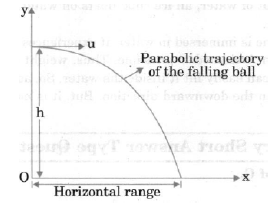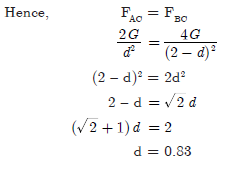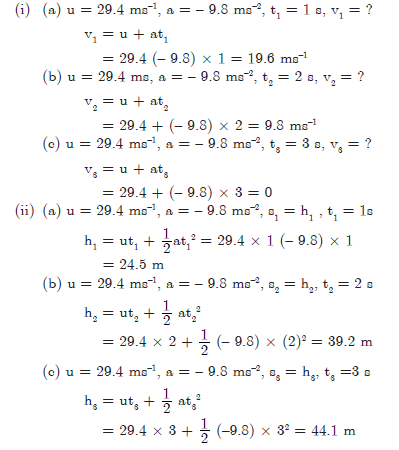Students should practice questions given in Gravitation Chapter 9 Class 9 Science Worksheets. These worksheets for Class 9 Science have a good collection of important questions and answers which are expected to come in your class tests and examinations. You should learn these solved worksheet questions for Science Class 9 as it will help you to understand all topics and give you more marks.
Class 9 Science Worksheets Chapter 9 Gravitation
Please refer to below questions and answers for Gravitation Chapter 9 Class 9 Science Worksheets. Prepared by expert teachers for Standard 9 Science
Question.Why should we be sent flying in space if the force of gravity somehow vanishes today?
Answer
The centripetal force required to keep us rotating along with the Earth would not be available in the absence of force of gravity. We would then fly off along the tangent to the Earth into the space.
Question.Why does a mug full of water feel lighter inside water?
Answer
A mug of water appears lighter inside the water because a buoyant force acts on the mug when placed inside the water.
Question.A ball moving on a table reaches the edge and falls.Sketch the path it will follow while falling.
Answer
As the ball falls, it has a horizontal velocity and a vertical downward acceleration due to gravity. Under the combined effect of these two motion the ball moves along a parabolic trajectory as shown in figure

Question.Name the force which accelerates a body in free fall.
Answer
Gravitational force of Earth.
Question.Define the weight of an object on Moon.
Answer
The weight of an object on the Moon is the force with which the Moon attracts that object.
Question.What is the unit of “g”?
Answer
The unit of “g” is ms–2.
Question.Why value of “g” more or less constant on or near the Earth?
Answer
Radius of Earth does not change much; “g” is more or less constant on or near the Earth.
Question.What is weightlessness?
Answer
A body is said to be in a state of weightlessness when the reaction of the supporting surface is zero or its apparent weight is zero.
Question. How does the force of gravitation between two objects change when the distance between them is reduced to half?
Answer. When the distance between the objects is reduced to half the gravitational force increases by four times the original force.
Question. The gravitational force acts on all objects in proportion to their masses. Why, then, a heavy object does not fall faster than a light object?
Answer. Acceleration due to gravity does not depend on mass of object. Hence, all bodies fall with the same acceleration provided there is no air or other resistance.
Question. Discuss the variation of weight of a body with the Latitude of Earth and Altitude of Earth.
Answer.
(i) Earth is not a perfect sphere.
(ii) Its radius at equator is longer than at the poles.
(iii) The acceleration due to gravity is inversely proportional to the square of the radius.
(iv) Therefore, the value of “g” at the poles is higher than that at the equator.
(v) As a result, the weight of an object increases if it moves from the equator to the poles.
Question. Why the value of ‘g’ decreases when we move from the poles to the equator?
Answer. The shape of Earth is an ellipse so when we move from the poles to the equator the radius of the Earth R increases. Hence, the value of ‘g’ decreases because value ‘g’ is inversely proportional to the radius of Earth.
g=GM/R2
Question. Why are objects in free fall weightless?
Answer. An object falling freely is accelerated downward by gravity. Due to the downward acceleration, it experiences an upward inertial force. This upward force cancels the downward gravitational force. Hence, the object is weightless.
Question. How can a person lie on a bed of nails without getting hurt?
Answer. Weight is spread out over them all making the pressure on each individual nail just about equal to a pinch if there are many nails. The greater the number of nails the lesser will be the pressure per square inch. If there are a large number of nails, it will be almost like lying on a solid surface.
Question. Explain : Centrifugal force and Centripetal force.
Answer. A force which is required to move a body uniformly in a circle is known as centripetal force. This force acts along the radius and towards the centre of the circle, centrifugal force arises when a body is moving actually along a circular path, by virtue of tendency of the body to regain its natural straight line path. This force acts along the radius and away from the centre of the circle.
Numerical Questions
Question. Let us find force of attraction between two blocks lying 1 m apart. Let the mass of each block is 40 kg.
Answer.
F = ?
m1 = 40 kg
m2 = 40 kg
d = 1 m
G = 6.67 × 10–11 Nm2kg–2

= 1.0672×10-7N
Question. The gravitational force between two objects is 49 N.How much distance between these objects be decreased so that the force between them becomes double?
Answer.
Let ‘r’ be the distance between the object of mass m1 and m2

Now, the distance is reduced to ‘x’ so that the force become twice, then

Dividing eq. (i) by (ii)

So, the distance must decrease by 1/√2 times the original distance.
Question. Two bodies A and B having masses 2 kg and 4 kg respectively are separated by 2 m. Where should a body of mass 1 kg be placed so that the gravitational force on this body due to bodies A and B is zero?
Answer.
Mass of body a is Ma = 2 kg
Mass of body b is Mb = 4 kg
Mass of body c is Mc = 1 kg
Separation between a and b = 2 m
Let the body C be placed at a distance d from body A Gravitational force between A and C

Gravitational force between B and C is

For body C the gravitational force is 0.

Question.Calculate the force of gravitation due to a child of mass 25 kg on his mother of mass 75 kg if the distance between their centres is 1 m from each other. Given
G = (20/3) × 10–11 Nm2 kg–2.
Ans :
Here m1 = 25 kg; m2 = 75 kg; d = 1 m;
G =20/3 × 10–11 Nm2 kg–2

F = 12,500 × 10–11
or F = 1.25 × 10–7 N
Question.A boy drops a stone from the edge of the roof. It passes a window 2 m high in 0.1 s. How far is the roof above the top of the window?
Ans :
Let a stone be dropped from the edge of the roof A.
Let it passes over B with a velocity say u. Consider motion BC.
u = ?, a = 9.8 ms–2; s = h = 2 m; t = 0.1 s
Using s = ut + 1/2 gt2 , we have
2 = u(0.1) +9.8/2 (0.1)2
2 = 0.1u + 0.049
0.1 u = 2 – 0.049
or u = 19.51 ms–1
This initial velocity at B in motion BC is the final velocity in motion AB.
Considering motion AB, we have
u = 0; v = 19.51 ms–1; s = ?; a = 9.8 ms–2
Using v2 – u2 = 2as, we have
(19.51)2 – (0)2 = 2 × 9.8 s
or s = 19.4 m
Roof is 19.4 m above the window.
Question. A ball thrown up is caught by the thrower after 4 s. With what velocity was it thrown up? How high did it go? Where was it after 3 s ? (g = 9.8 ms–2)
Answer. Since, the time of going up is the same as that of coming down, therefore, time of going up = 4/2 = 2 s.
Let it starts upward with velocity u.
Here u = ?; a = – 9.8 ms–2; t = 2 s; v = 0 (at the top); s = h
Using v = u + at
or 0 = u – 9.8 × 2
or u = 19.6 ms–1
Again v2 – u2 = 2as
0 – (19.6)2 = 2 (–9.8) h
h = 19.6 m
After 2 s, it starts coming downwards (starting with u = 0). Considering downward motion,
u = 0; a = 9.8 ms–2; t = 3 – 2= 1s;
s = ?
s = ut + 1/2at2
or s = 0 × 9.8/2(1)2 = 4.9 m from top.
Question. Coconut is hanging on a tree at a height of 15 m from the ground. A boy launches a projectile vertically upwards with a velocity of 20 ms–1. After what time the projectile pass by coconut? Explain the two answer in this problem.
Answer.
Here u = 20 ms–1; a = – 10 ms–2; s = 15 m; t = ?
Using s = ut + 1/2at2, we have
15 = 20t + 1/2 (–10)t2
Dividing throughout by 5, we have
3 = 4t – t2
or t2 – 4t + 3 = 0
or (t – 1) (t – 3) = t – 1 = 0 or t = ls
or t – 3 = 0 or t = 3 s
After 1 s, it will cross coconut while going up and after 3 s while coming down.
Question. A sealed tin of Coca Cola of 400 g has a volume of 300 cm3. Calculate the density of the tin.
Answer.
Here, mass of tin, M = 400 g
Volume of tin, V = 300 cm3

D = 1.33 g cm–3
Question. A sealed can of mass 600 g has a volume of 500 cm3. Will this can sink in water? Density of water is 1 g cm–3.
Answer.
Here, mass of can, M = 600 g
Volume of can, V = 500 cm3
Density of can, D =M/V cm = 600g/500cm3
= 1.2 g cm–3
Since, density of the can is greater than the density of water, so the can will sink in water.
Question. A force of 200 N is applied perpendicular to its surface having area 4 square metres. Calculate the pressure.
Answer.
Thrust = 200 N
Area = 4 m2
Pressure = ?
Pressure = Thrust/Area = 200 N/4 m2
= 50 Nm–2 = 50 Pa
Question. The density of water is 1000 kg m3. If relative density of iron is 7.874, then calculate the density of iron.
Answer.
Density of water = 1000 kg/m3
Relative density (R.D.) of iron = 7.874
Using, R.D. of iron we get
Density of iron = R.D. of iron × density of water
= 7.874 × 1000 kg/m3
= 7874 kg/m3.
Question. A plastic bottle of 500 g has a volume of 450 cm3. Will the bottle float or sink in water? Density of water is 1 g cm–3? Also calculate the mass of the water displaced
Answer.
Mass, M = 500 g
Volume, V = 450 cm3
Density of bottle, D = M/V =500g/450cm3
= 1.11 g cm–3
Since, density of bottle is greater than the density of water (1 g cm3), so the bottle will sink in water.
Mass of water displaced by the bottle
= Volume of water displaced × Density of water
= Volume of bottle × Density of water
= 450 cm3 × 1 g cm3
= 450 g.
Question. What is the force of gravitation between two point masses of 1 kg and 2 kg kept 1 m apart?
Answer.
m = 1 kg, m2 = 2 kg, r = 1 m

= 13.34×10-11 N
This is an extremely small force.
Question. A particle is thrown up vertically with a velocity of 50 m/s.
(a) What will be its velocity at the highest point of its journey?
(b) How high would the particle rise?
(c) What time would it take to reach the highest point?
Answer.
At the highest point the velocity will be zero.
Considering activity A to B
Using v = u + at
0 = 50 – 9.8 × t
t = 5.1 sec
Also v2 – u2 = 2as
02 – (50)2 = 2 (– 9.8) × s
s = 127.5 m
Question. A ball is dropped from the top of a tower 40 m high.What is its velocity when it has covered 20 m? What would be its velocity when it hits the ground? Take g = 10 m/s2.
Answer. Let the point B be at a height of 20 m.
Activity from A to B :
u1 = 0, a1= 10 ms–2,
s1 = 20 m, v1 = ?
v12 – u12 = 2a1s1
v12 – 02 = 2 (10) (20)
v12 = 202
v1 = 20 m/s
Activity from A to C : C is a point on the ground
u2 = 0, a2 = 10 ms–2, s2 = 40 m,
v2 = ?
v22 – u22 = 2a2s2
v22 – 02 = 2 (10)(40)
v22 = 800
v2 = 28.28 ms–1
Question. A body is thrown up with a speed 29.4 ms–1.
(i) What is its speed after (a) t = 1 s, (b) t = 2 s and (c) t = 3 s.
(ii) What is its height after (a) t = 1 s, (b) t = 2 s and (c) t = 3 s.
Answer.
